flat tire MERCEDES-BENZ GLK-Class 2014 X204 Owner's Manual
[x] Cancel search | Manufacturer: MERCEDES-BENZ, Model Year: 2014, Model line: GLK-Class, Model: MERCEDES-BENZ GLK-Class 2014 X204Pages: 382, PDF Size: 4.36 MB
Page 8 of 382
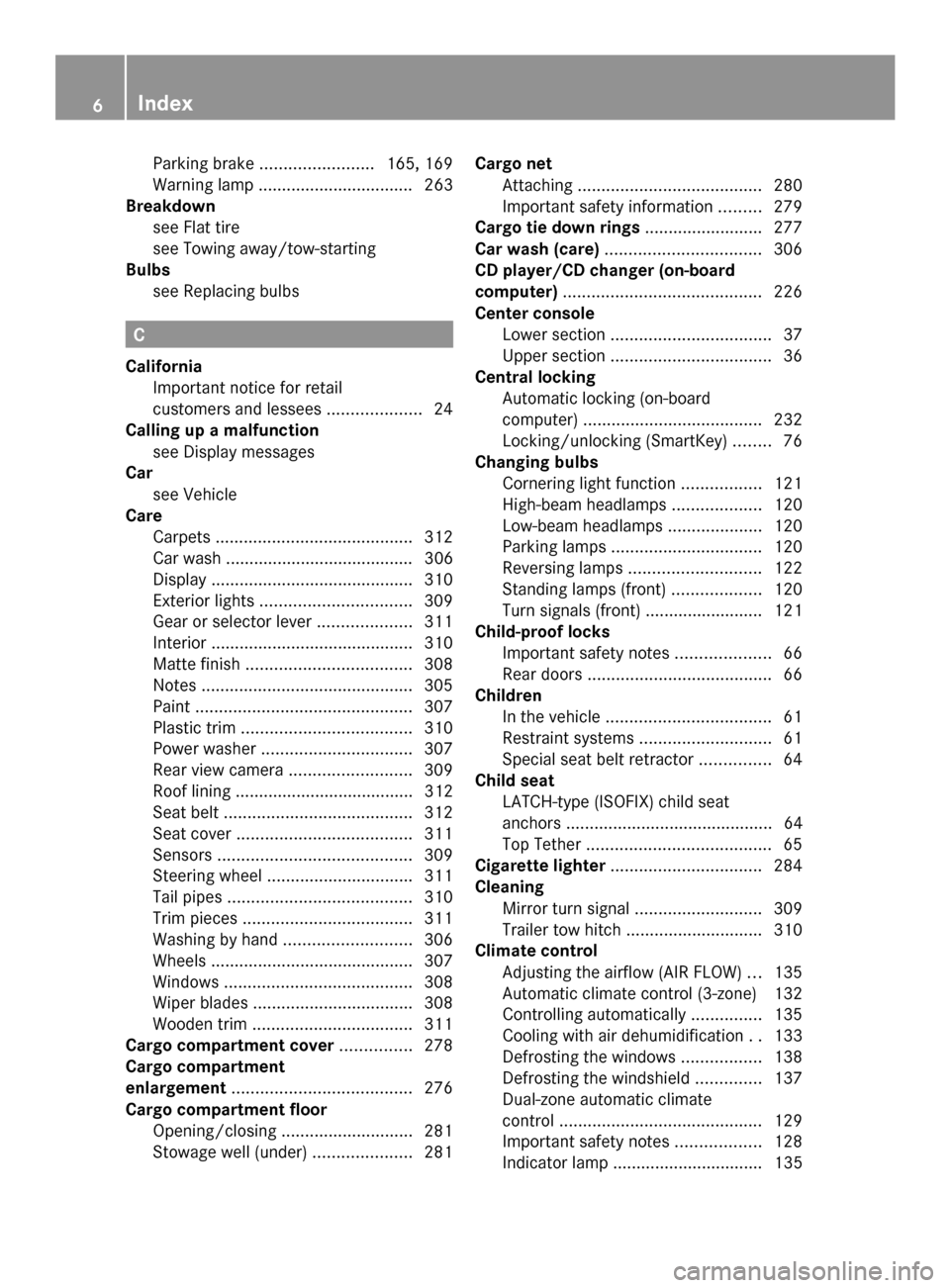
Parking brake
........................ 165, 169
Warning lamp ................................. 263
Breakdown
see Flat tire
see Towing away/tow-starting
Bulbs
see Replacing bulbs C
California Important notice for retail
customers and lessees ....................24
Calling up a malfunction
see Display messages
Car
see Vehicle
Care
Carpets .......................................... 312
Car wash ........................................ 306
Display ........................................... 310
Exterior lights ................................ 309
Gear or selector lever ....................311
Interior ........................................... 310
Matte finish ................................... 308
Notes ............................................. 305
Paint .............................................. 307
Plastic trim .................................... 310
Power washer ................................ 307
Rear view camera .......................... 309
Roof lining ...................................... 312
Seat belt ........................................ 312
Seat cover ..................................... 311
Sensors ......................................... 309
Steering wheel ............................... 311
Tail pipes ....................................... 310
Trim pieces .................................... 311
Washing by hand ........................... 306
Wheels ........................................... 307
Windows ........................................ 308
Wiper blades .................................. 308
Wooden trim .................................. 311
Cargo compartment cover ...............278
Cargo compartment
enlargement ...................................... 276
Cargo compartment floor Opening/closing ............................ 281
Stowage well (under) .....................281Cargo net
Attaching ....................................... 280
Important safety information .........279
Cargo tie down rings .........................277
Car wash (care) ................................. 306
CD player/CD changer (on-board
computer) .......................................... 226
Center console Lower section .................................. 37
Upper section .................................. 36
Central locking
Automatic locking (on-board
computer) ...................................... 232
Locking/unlocking (SmartKey) ........76
Changing bulbs
Cornering light function .................121
High-beam headlamps ...................120
Low-beam headlamps ....................120
Parking lamps ................................ 120
Reversing lamps ............................ 122
Standing lamps (front) ...................120
Turn signals (front) ......................... 121
Child-proof locks
Important safety notes ....................66
Rear doors ....................................... 66
Children
In the vehicle ................................... 61
Restraint systems ............................ 61
Special seat belt retractor ...............64
Child seat
LATCH-type (ISOFIX) child seat
anchors ............................................ 64
Top Tether ....................................... 65
Cigarette lighter ................................ 284
Cleaning Mirror turn signal ........................... 309
Trailer tow hitch ............................. 310
Climate control
Adjusting the airflow (AIR FLOW) ...135
Automatic climate control (3-zone) 132
Controlling automatically ...............135
Cooling with air dehumidification ..133
Defrosting the windows .................138
Defrosting the windshield ..............137
Dual-zone automatic climate
control ........................................... 129
Important safety notes ..................128
Indicator lamp ................................ 135 6
Index
Page 12 of 382
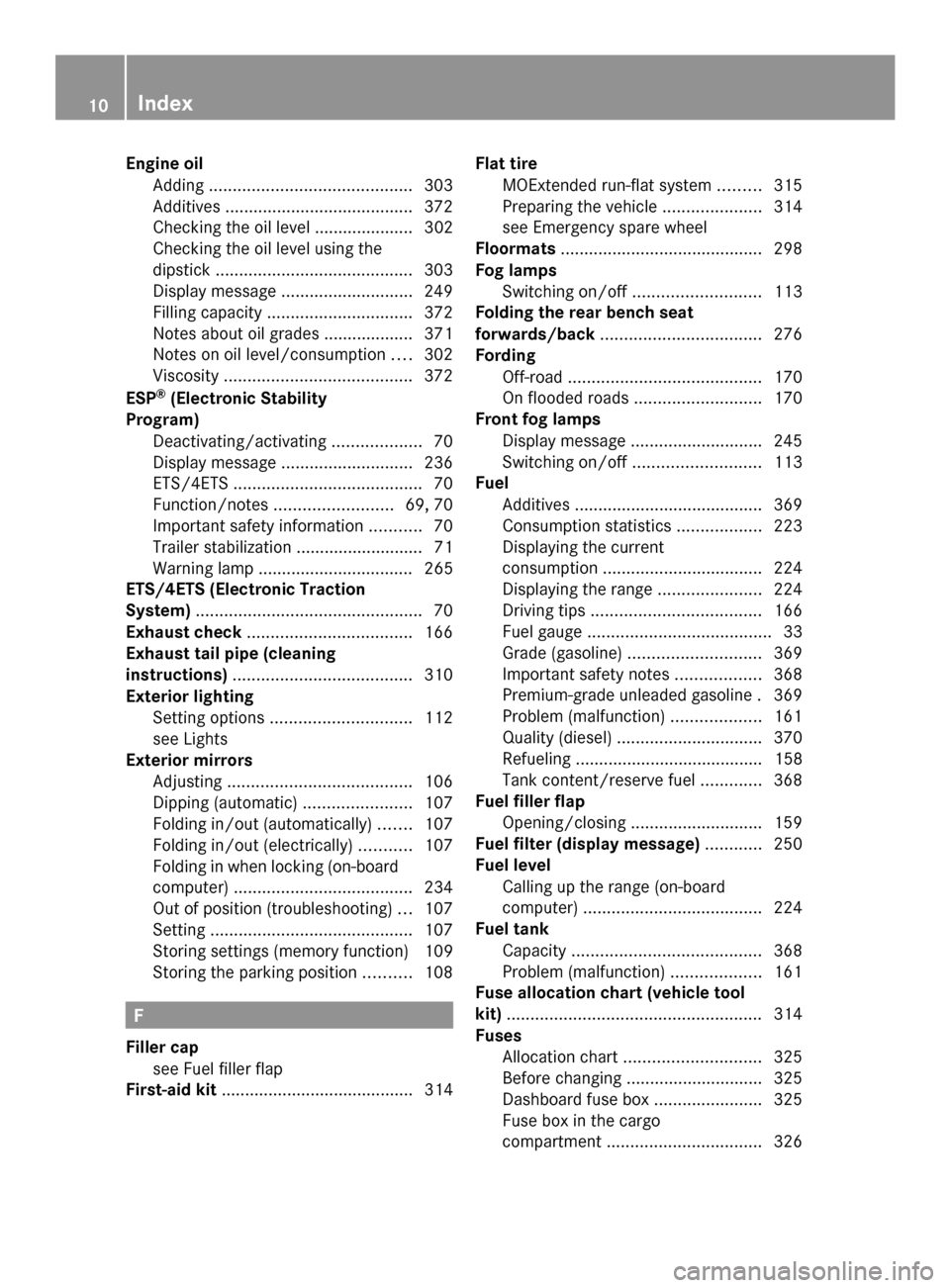
Engine oil
Adding ........................................... 303
Additives ........................................ 372
Checking the oil level ..................... 302
Checking the oil level using the
dipstick .......................................... 303
Display message ............................ 249
Filling capacity ............................... 372
Notes about oil grades ................... 371
Notes on oil level/consumption ....302
Viscosity ........................................ 372
ESP ®
(Electronic Stability
Program) Deactivating/activating ...................70
Display message ............................ 236
ETS/4ETS ........................................ 70
Function/notes ......................... 69, 70
Important safety information ...........70
Trailer stabilization ........................... 71
Warning lamp ................................. 265
ETS/4ETS (Electronic Traction
System) ................................................ 70
Exhaust check ................................... 166
Exhaust tail pipe (cleaning
instructions) ...................................... 310
Exterior lighting Setting options .............................. 112
see Lights
Exterior mirrors
Adjusting ....................................... 106
Dipping (automatic) .......................107
Folding in/out (automatically). ......107
Folding in/out (electrically). ..........107
Folding in when locking (on-board
computer) ...................................... 234
Out of position (troubleshooting) ...107
Setting ........................................... 107
Storing settings (memory function) 109
Storing the parking position ..........108 F
Filler cap see Fuel filler flap
First-aid kit ......................................... 314 Flat tire
MOExtended run-flat system .........315
Preparing the vehicle .....................314
see Emergency spare wheel
Floormats ........................................... 298
Fog lamps Switching on/off ........................... 113
Folding the rear bench seat
forwards/back .................................. 276
Fording Off-road ......................................... 170
On flooded roads ........................... 170
Front fog lamps
Display message ............................ 245
Switching on/off ........................... 113
Fuel
Additives ........................................ 369
Consumption statistics ..................223
Displaying the current
consumption .................................. 224
Displaying the range ......................224
Driving tips .................................... 166
Fuel gauge ....................................... 33
Grade (gasoline) ............................ 369
Important safety notes ..................368
Premium-grade unleaded gasoline .369
Problem (malfunction) ...................161
Quality (diesel )............................... 370
Refueling ........................................ 158
Tank content/reserve fuel .............368
Fuel filler flap
Opening/closing ............................ 159
Fuel filter (display message) ............250
Fuel level Calling up the range (on-board
computer) ...................................... 224
Fuel tank
Capacity ........................................ 368
Problem (malfunction) ...................161
Fuse allocation chart (vehicle tool
kit) ...................................................... 314
Fuses Allocation chart ............................. 325
Before changing ............................. 325
Dashboard fuse box .......................325
Fuse box in the cargo
compartment ................................. 32610
Index
Page 21 of 382
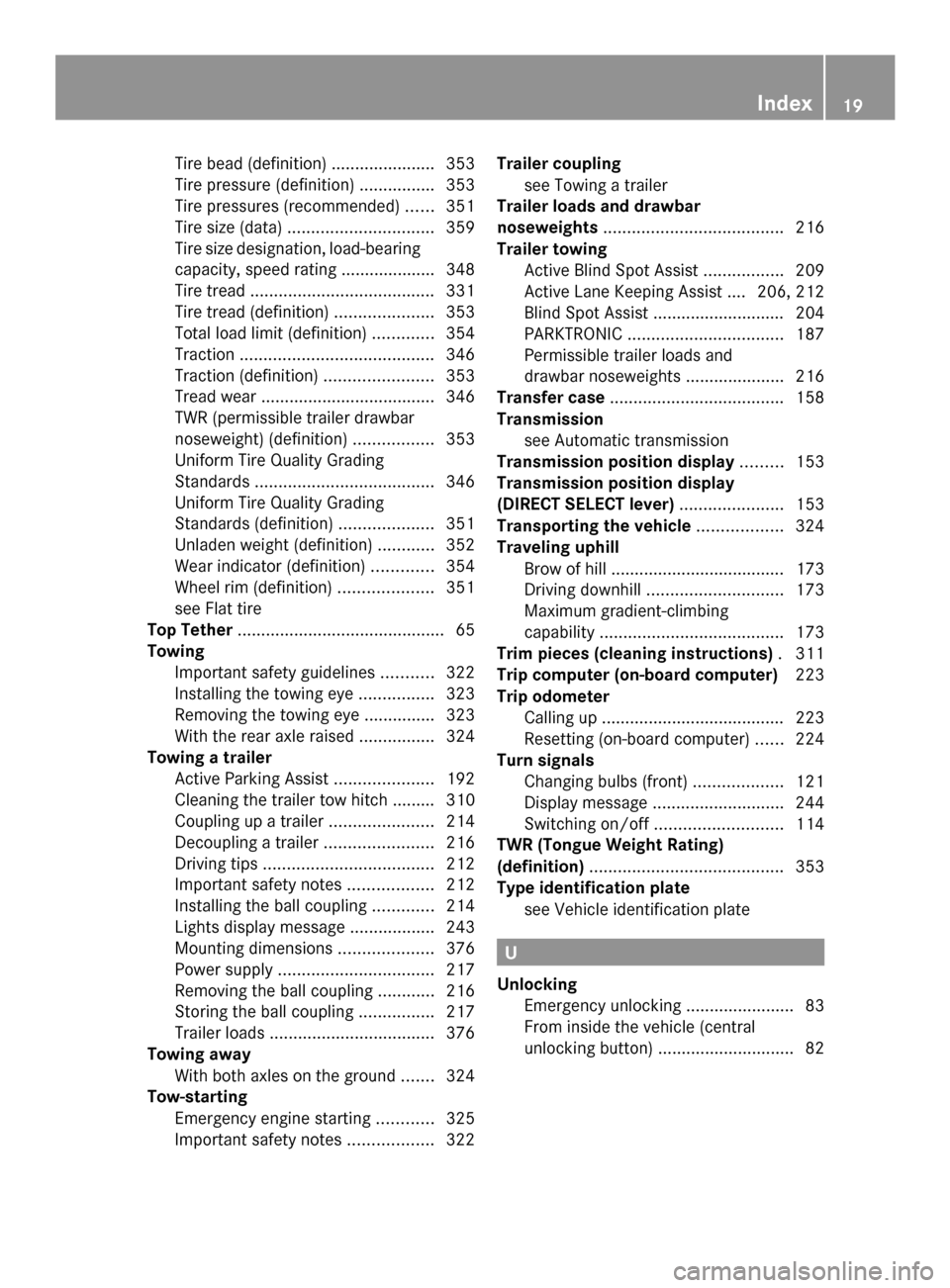
Tire bead (definition
)...................... 353
Tire pressure (definition) ................353
Tire pressures (recommended )...... 351
Tire size (data) ............................... 359
Tire size designation, load-bearing
capacity, speed rating .................... 348
Tire tread ....................................... 331
Tire tread (definition) .....................353
Total load limit (definition) .............354
Traction ......................................... 346
Traction (definition) .......................353
Tread wea r..................................... 346
TWR (permissible trailer drawbar
noseweight) (definition) .................353
Uniform Tire Quality Grading
Standards ...................................... 346
Uniform Tire Quality Grading
Standards (definition) ....................351
Unladen weight (definition) ............352
Wear indicator (definition) .............354
Wheel rim (definition) ....................351
see Flat tire
Top Tether ............................................ 65
Towing Important safety guidelines ...........322
Installing the towing eye ................323
Removing the towing eye ...............323
With the rear axle raised ................324
Towing a trailer
Active Parking Assist .....................192
Cleaning the trailer tow hitch ......... 310
Coupling up a trailer ......................214
Decoupling a trailer .......................216
Driving tips .................................... 212
Important safety notes ..................212
Installing the ball coupling .............214
Lights display message ..................243
Mounting dimensions ....................376
Power supply ................................. 217
Removing the ball coupling ............216
Storing the ball coupling ................217
Trailer loads ................................... 376
Towing away
With both axles on the ground .......324
Tow-starting
Emergency engine starting ............325
Important safety notes ..................322Trailer coupling
see Towing a trailer
Trailer loads and drawbar
noseweights ...................................... 216
Trailer towing Active Blind Spot Assist .................209
Active Lane Keeping Assist .... 206, 212
Blind Spot Assist ............................ 204
PARKTRONIC ................................. 187
Permissible trailer loads and
drawbar noseweights .....................216
Transfer case ..................................... 158
Transmission see Automatic transmission
Transmission position display .........153
Transmission position display
(DIRECT SELECT lever) ......................153
Transporting the vehicle ..................324
Traveling uphill Brow of hill ..................................... 173
Driving downhill ............................. 173
Maximum gradient-climbing
capability ....................................... 173
Trim pieces (cleaning instructions) .311
Trip computer (on-board computer) 223
Trip odometer Calling up ....................................... 223
Resetting (on-board computer) ......224
Turn signals
Changing bulbs (front) ...................121
Display message ............................ 244
Switching on/off ........................... 114
TWR (Tongue Weight Rating)
(definition) ......................................... 353
Type identification plate see Vehicle identification plate U
Unlocking Emergency unlocking .......................83
From inside the vehicle (central
unlocking button) ............................. 82 Index
19
Page 168 of 382
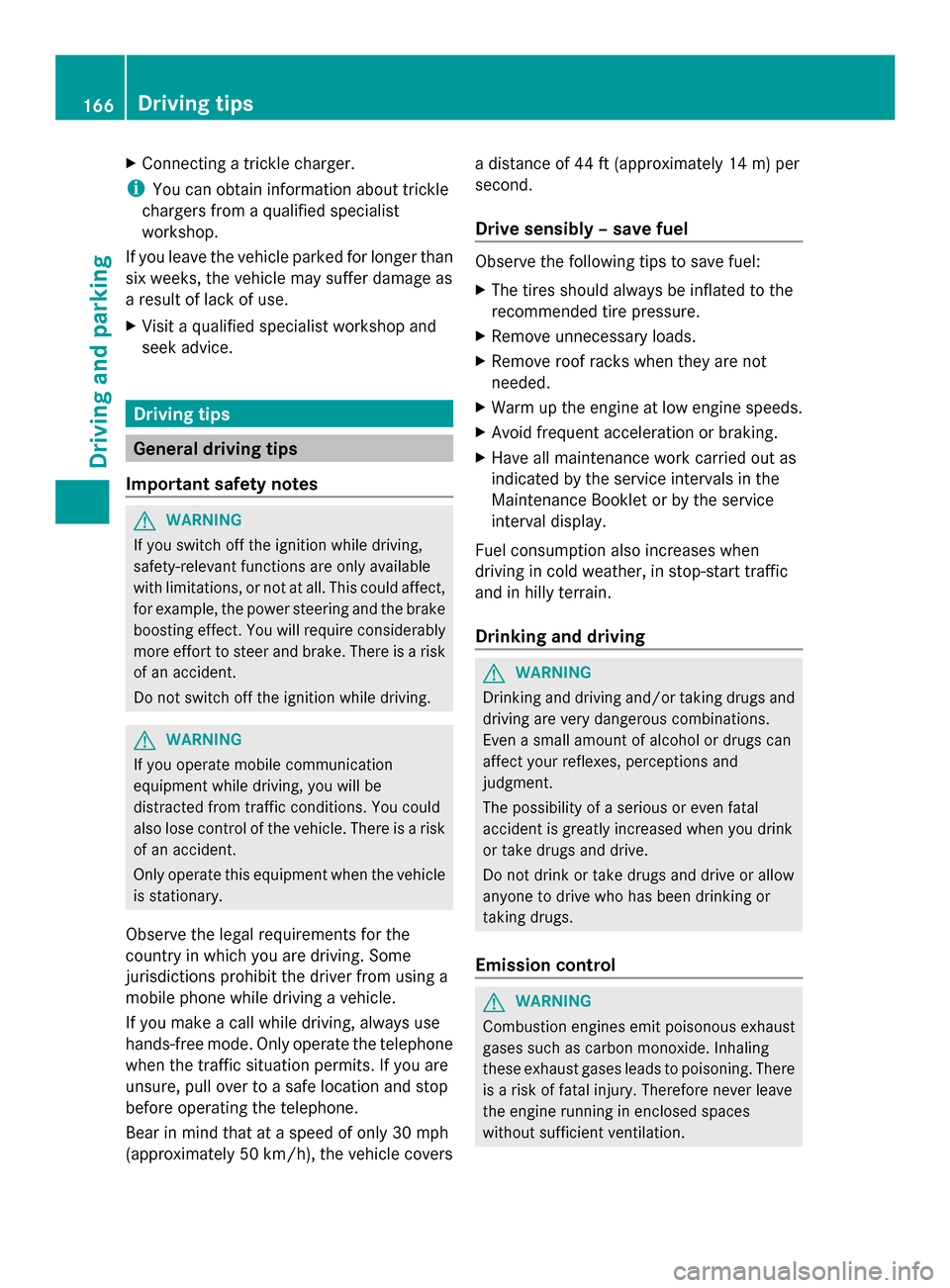
X
Connecting a trickle charger.
i You can obtain information about trickle
chargers from a qualified specialist
workshop.
If you leave the vehicle parked for longer than
six weeks, the vehicle may suffer damage as
a result of lack of use.
X Visit a qualified specialist workshop and
seek advice. Driving tips
General driving tips
Important safety notes G
WARNING
If you switch off the ignition while driving,
safety-relevant functions are only available
with limitations, or not at all. This could affect,
for example, the power steering and the brake
boosting effect. You will require considerably
more effort to steer and brake. There is a risk
of an accident.
Do not switch off the ignition while driving. G
WARNING
If you operate mobile communication
equipment while driving, you will be
distracted from traffic conditions. You could
also lose control of the vehicle. There is a risk
of an accident.
Only operate this equipment when the vehicle
is stationary.
Observe the legal requirements for the
country in which you are driving. Some
jurisdictions prohibit the driver from using a
mobile phone while driving a vehicle.
If you make a call while driving, always use
hands-free mode. Only operate the telephone
when the traffic situation permits. If you are
unsure, pull over to a safe location and stop
before operating the telephone.
Bear in mind that at a speed of only 30 mph
(approximately 50 km/h), the vehicle covers a distance of 44 ft (approximately 14 m) per
second.
Drive sensibly – save fuel Observe the following tips to save fuel:
X
The tires should always be inflated to the
recommended tire pressure.
X Remove unnecessary loads.
X Remove roof racks when they are not
needed.
X Warm up the engine at low engine speeds.
X Avoid frequent acceleration or braking.
X Have all maintenance work carried out as
indicated by the service intervals in the
Maintenance Booklet or by the service
interval display.
Fuel consumption also increases when
driving in cold weather, in stop-start traffic
and in hilly terrain.
Drinking and driving G
WARNING
Drinking and driving and/or taking drugs and
driving are very dangerous combinations.
Even a small amount of alcohol or drugs can
affect your reflexes, perceptions and
judgment.
The possibility of a serious or even fatal
accident is greatly increased when you drink
or take drugs and drive.
Do not drink or take drugs and drive or allow
anyone to drive who has been drinking or
taking drugs.
Emission control G
WARNING
Combustion engines emit poisonous exhaust
gases such as carbon monoxide. Inhaling
these exhaust gases leads to poisoning. There
is a risk of fatal injury. Therefore never leave
the engine running in enclosed spaces
without sufficient ventilation. 166
Driving tipsDriving and pa
rking
Page 172 of 382
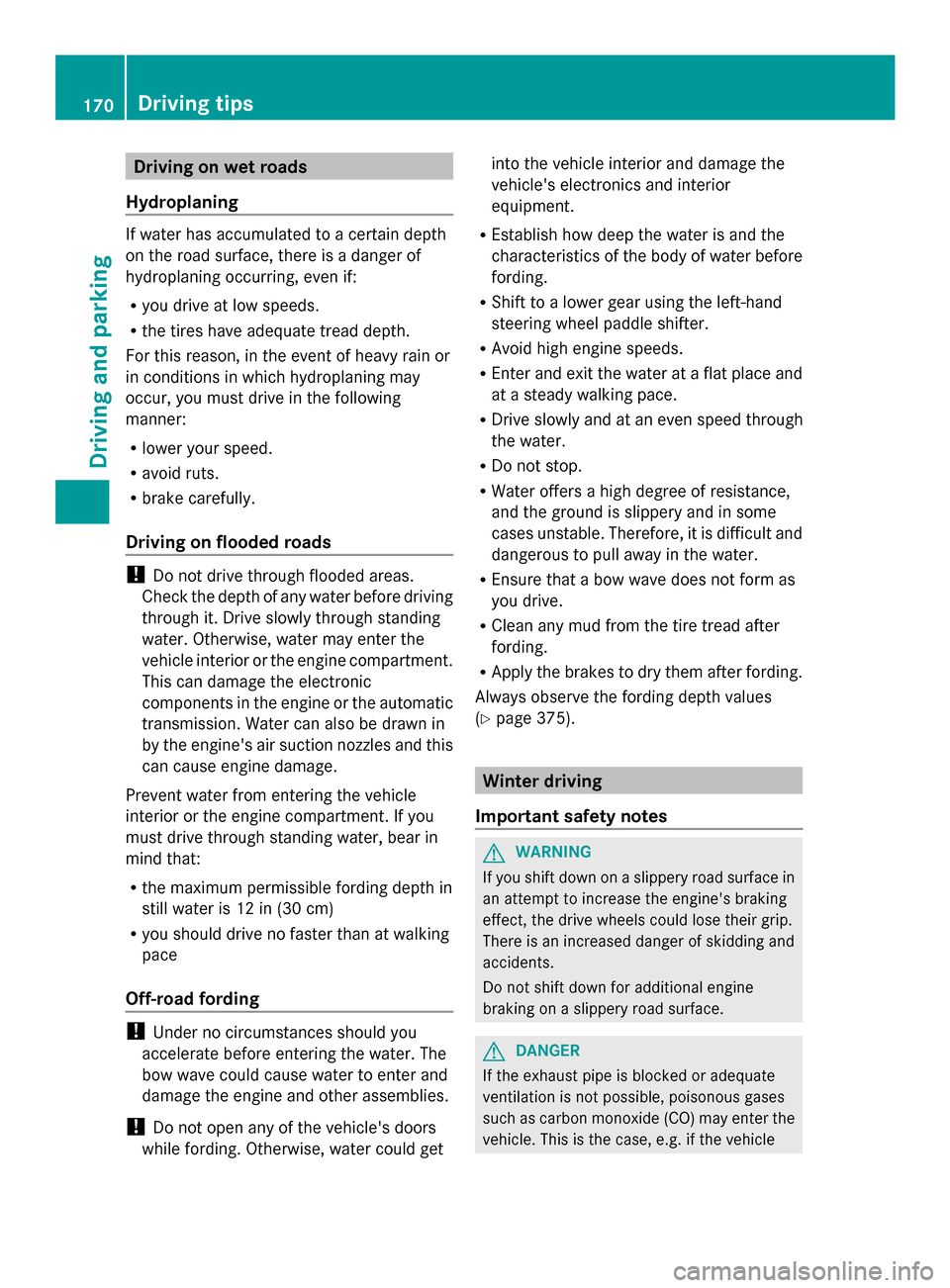
Driving on wet roads
Hydroplaning If water has accumulated to a certain depth
on the road surface, there is a danger of
hydroplaning occurring, even if:
R you drive at low speeds.
R the tires have adequate tread depth.
For this reason, in the event of heavy rain or
in conditions in which hydroplaning may
occur, you must drive in the following
manner:
R lower your speed.
R avoid ruts.
R brake carefully.
Driving on flooded roads !
Do not drive through flooded areas.
Check the depth of any water before driving
through it. Drive slowly through standing
water. Otherwise, water may enter the
vehicle interior or the engine compartment.
This can damage the electronic
components in the engine or the automatic
transmission. Water can also be drawn in
by the engine's air suction nozzles and this
can cause engine damage.
Prevent water from entering the vehicle
interior or the engine compartment. If you
must drive through standing water, bear in
mind that:
R the maximum permissible fording depth in
still water is 12 in (30 cm)
R you should drive no faster than at walking
pace
Off-road fording !
Under no circumstances should you
accelerate before entering the water. The
bow wave could cause water to enter and
damage the engine and other assemblies.
! Do not open any of the vehicle's doors
while fording. Otherwise, water could get into the vehicle interior and damage the
vehicle's electronics and interior
equipment.
R Establish how deep the water is and the
characteristics of the body of water before
fording.
R Shift to a lower gear using the left-hand
steering wheel paddle shifter.
R Avoid high engine speeds.
R Enter and exit the water at a flat place and
at a steady walking pace.
R Drive slowly and at an even speed through
the water.
R Do not stop.
R Water offers a high degree of resistance,
and the ground is slippery and in some
cases unstable. Therefore, it is difficult and
dangerous to pull away in the water.
R Ensure that a bow wave does not form as
you drive.
R Clean any mud from the tire tread after
fording.
R Apply the brakes to dry them after fording.
Always observe the fording depth values
(Y page 375). Winter driving
Important safety notes G
WARNING
If you shift down on a slippery road surface in
an attempt to increase the engine's braking
effect, the drive wheels could lose their grip.
There is an increased danger of skidding and
accidents.
Do not shift down for additional engine
braking on a slippery road surface. G
DANGER
If the exhaust pipe is blocked or adequate
ventilation is not possible, poisonous gases
such as carbon monoxide (CO) may enter the
vehicle. This is the case, e.g. if the vehicle 170
Driving tipsDriving and pa
rking
Page 258 of 382
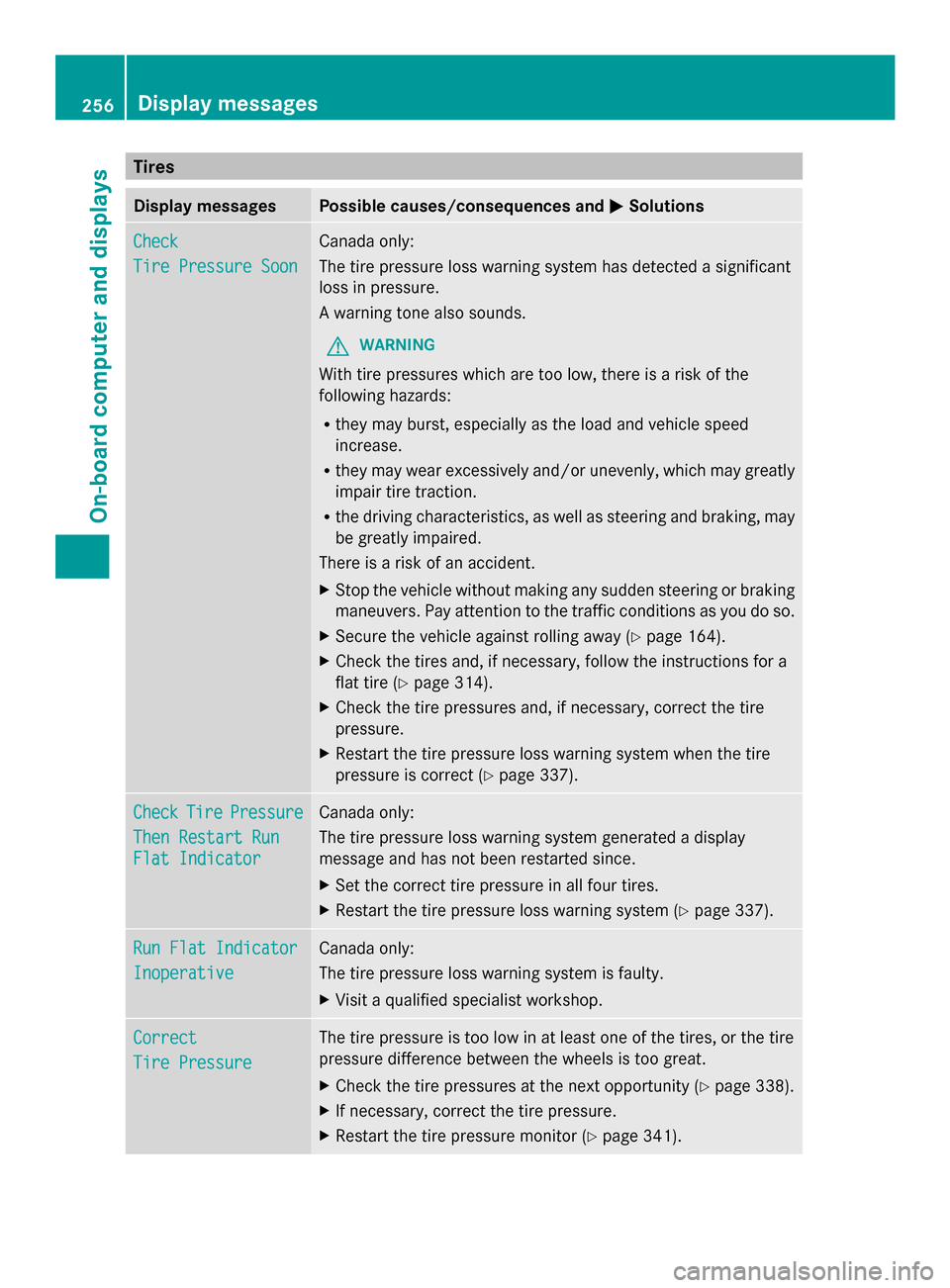
Tires
Display messages Possible causes/consequences and
0050
0050Solutions Check
Check
Tire Pressure Soon Tire Pressure Soon Canada only:
The tire pressure loss warning system has detected a significant
loss in pressure.
A warning tone also sounds.
G WARNING
With tire pressures which are too low, there is a risk of the
following hazards:
R they may burst, especially as the load and vehicle speed
increase.
R they may wear excessively and/or unevenly, which may greatly
impair tire traction.
R the driving characteristics, as well as steering and braking, may
be greatly impaired.
There is a risk of an accident.
X Stop the vehicle without making any sudden steering or braking
maneuvers. Pay attention to the traffic conditions as you do so.
X Secure the vehicle against rolling away (Y page 164).
X Check the tires and, if necessary, follow the instructions for a
flat tire (Y page 314).
X Check the tire pressures and, if necessary, correct the tire
pressure.
X Restart the tire pressure loss warning system when the tire
pressure is correct (Y page 337).Check Check
Tire
TirePressure
Pressure
Then Restart Run
Then Restart Run
Flat Indicator Flat Indicator Canada only:
The tire pressure loss warning system generated a display
message and has not been restarted since.
X
Set the correct tire pressure in all four tires.
X Restart the tire pressure loss warning system (Y page 337).Run Flat Indicator Run Flat Indicator
Inoperative Inoperative Canada only:
The tire pressure loss warning system is faulty.
X
Visit a qualified specialist workshop. Correct Correct
Tire Pressure Tire Pressure The tire pressure is too low in at least one of the tires, or the tire
pressure difference between the wheels is too great.
X Check the tire pressures at the next opportunity (Y page 338).
X If necessary, correct the tire pressure.
X Restart the tire pressure monitor (Y page 341).256
Display
messagesOn-board computer and displays
Page 259 of 382
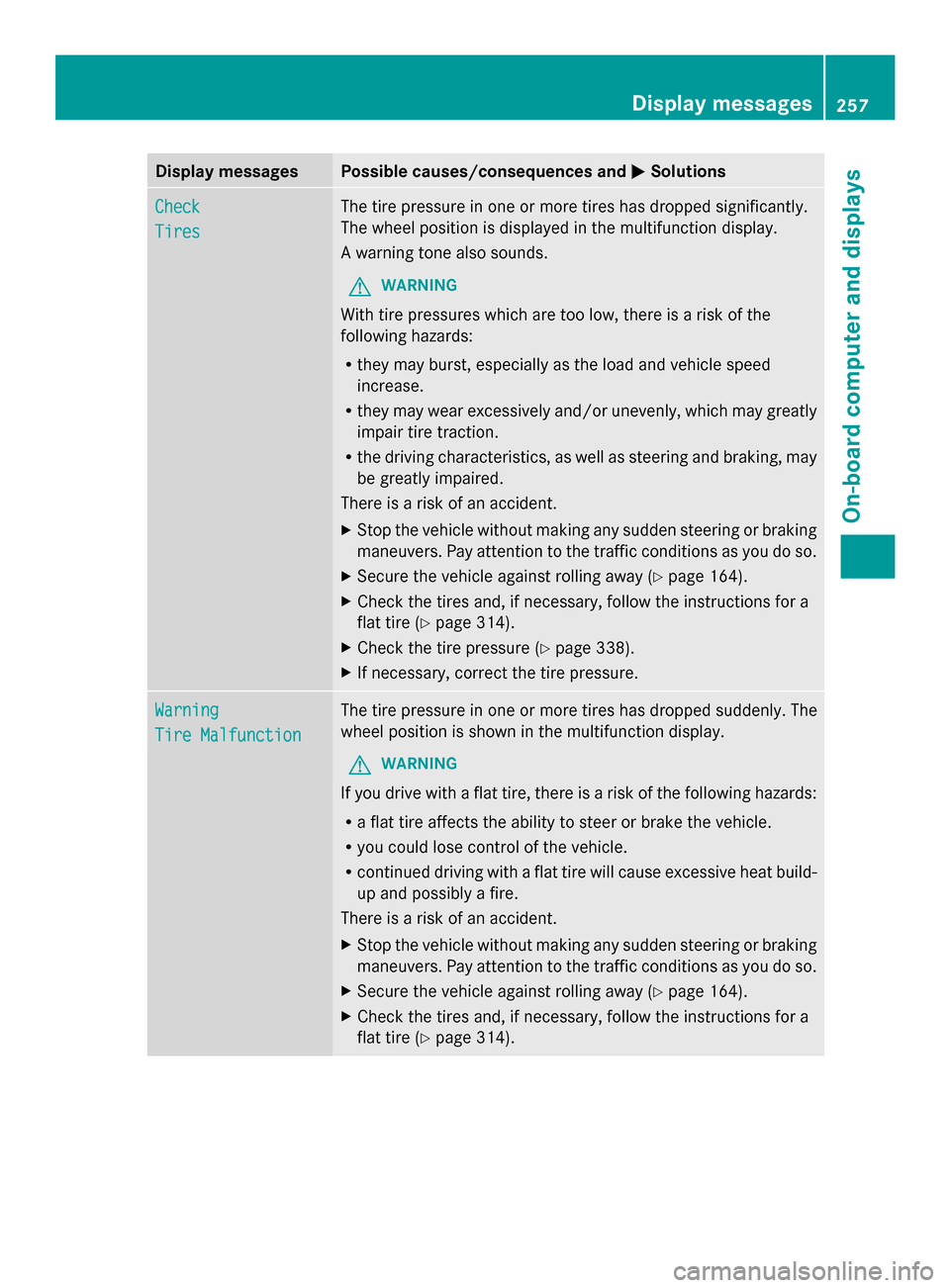
Display messages Possible causes/consequences and
0050
0050Solutions Check
Check
Tires Tires The tire pressure in one or more tires has dropped significantly.
The wheel position is displayed in the multifunction display.
A warning tone also sounds.
G WARNING
With tire pressures which are too low, there is a risk of the
following hazards:
R they may burst, especially as the load and vehicle speed
increase.
R they may wear excessively and/or unevenly, which may greatly
impair tire traction.
R the driving characteristics, as well as steering and braking, may
be greatly impaired.
There is a risk of an accident.
X Stop the vehicle without making any sudden steering or braking
maneuvers. Pay attention to the traffic conditions as you do so.
X Secure the vehicle against rolling away ( Ypage 164).
X Check the tires and, if necessary, follow the instructions for a
flat tire (Y page 314).
X Check the tire pressure (Y page 338).
X If necessary, correct the tire pressure. Warning Warning
Tire Malfunction Tire Malfunction The tire pressure in one or more tires has dropped suddenly. The
wheel position is shown in the multifunction display.
G WARNING
If you drive with a flat tire, there is a risk of the following hazards:
R a flat tire affects the ability to steer or brake the vehicle.
R you could lose control of the vehicle.
R continued driving with a flat tire will cause excessive heat build-
up and possibly a fire.
There is a risk of an accident.
X Stop the vehicle without making any sudden steering or braking
maneuvers. Pay attention to the traffic conditions as you do so.
X Secure the vehicle against rolling away ( Ypage 164).
X Check the tires and, if necessary, follow the instructions for a
flat tire (Y page 314). Display
messages
257On-board computer and displays Z
Page 274 of 382
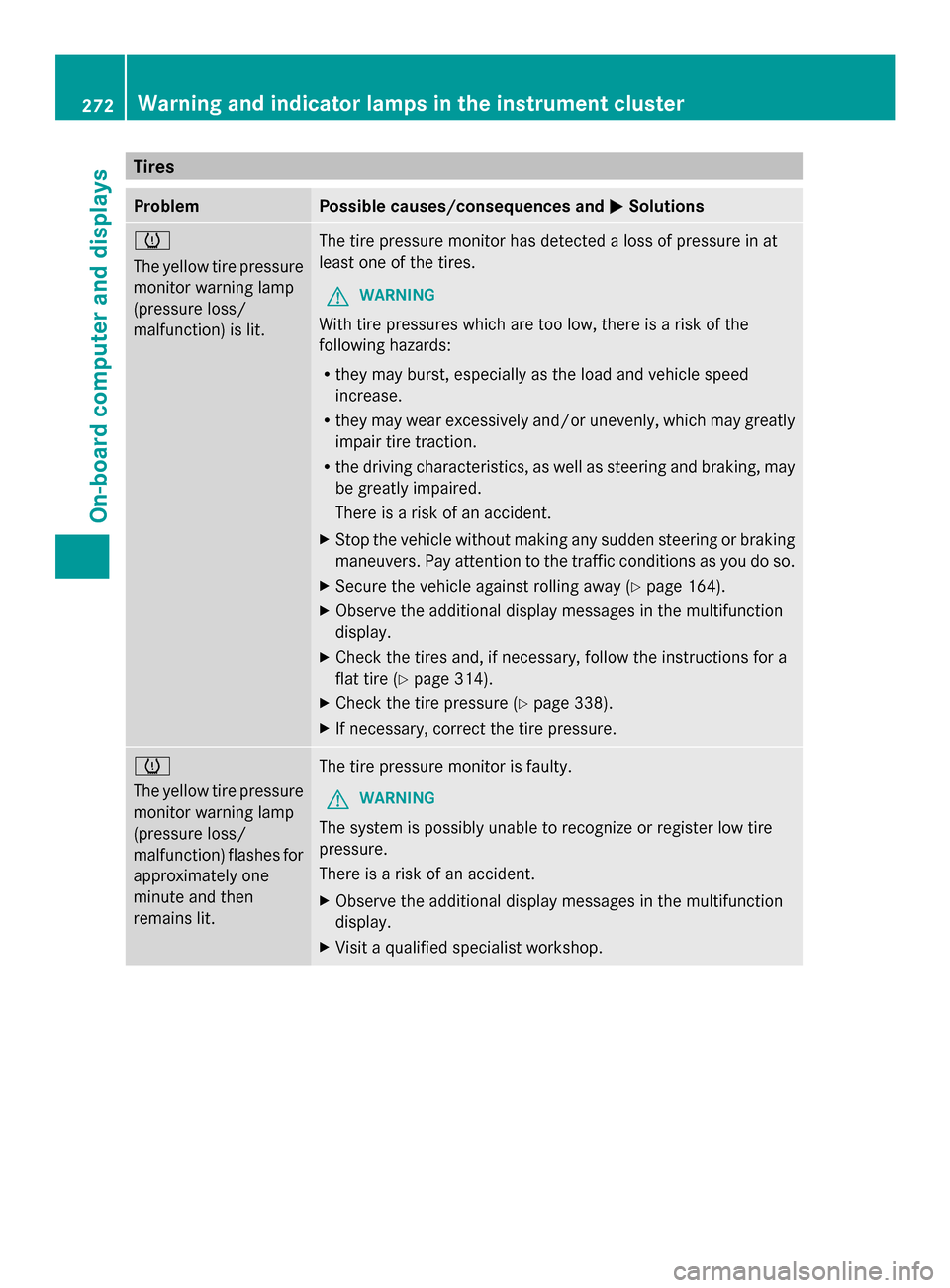
Tires
Problem Possible causes/consequences and
0050
0050Solutions 0077
The yellow tire pressure
monitor warning lamp
(pressure loss/
malfunction) is lit.
The tire pressure monitor has detected a loss of pressure in at
least one of the tires.
G WARNING
With tire pressures which are too low, there is a risk of the
following hazards:
R they may burst, especially as the load and vehicle speed
increase.
R they may wear excessively and/or unevenly, which may greatly
impair tire traction.
R the driving characteristics, as well as steering and braking, may
be greatly impaired.
There is a risk of an accident.
X Stop the vehicle without making any sudden steering or braking
maneuvers. Pay attention to the traffic conditions as you do so.
X Secure the vehicle against rolling away (Y page 164).
X Observe the additional display messages in the multifunction
display.
X Check the tires and, if necessary, follow the instructions for a
flat tire (Y page 314).
X Check the tire pressure (Y page 338).
X If necessary, correct the tire pressure. 0077
The yellow tire pressure
monitor warning lamp
(pressure loss/
malfunction) flashes for
approximately one
minute and then
remains lit.
The tire pressure monitor is faulty.
G WARNING
The system is possibly unable to recognize or register low tire
pressure.
There is a risk of an accident.
X Observe the additional display messages in the multifunction
display.
X Visit a qualified specialist workshop. 272
Warning and indicator lamps in the instrument clusterOn-board computer and displays
Page 315 of 382
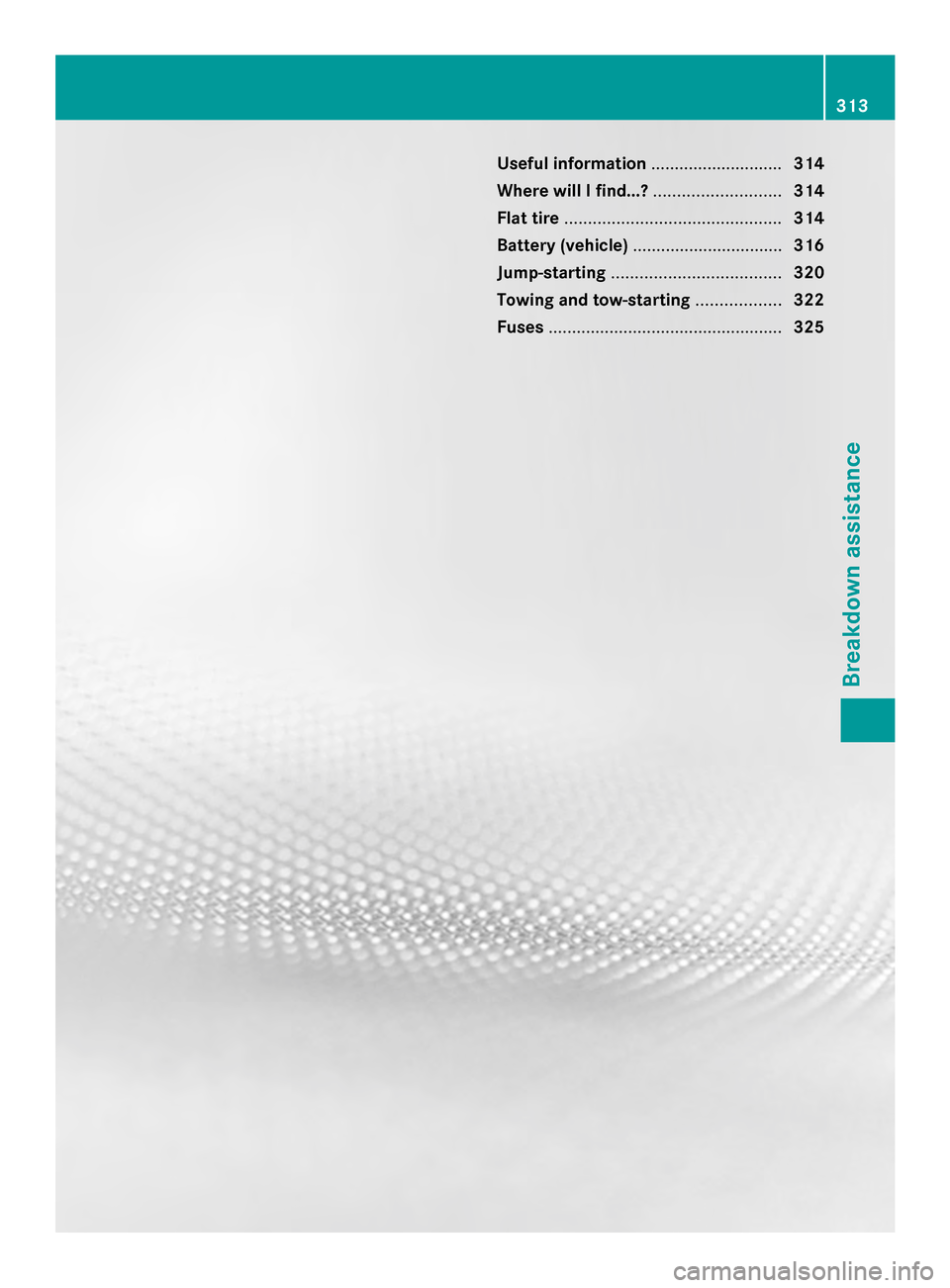
Useful information
............................314
Where will I find...? ...........................314
Flat tire .............................................. 314
Battery (vehicle) ................................ 316
Jump-starting .................................... 320
Towing and tow-starting ..................322
Fuses .................................................. 325 313Breakdown assistance
Page 316 of 382

Useful information
i This Operator's Manual describes all
models and all standard and optional
equipment of your vehicle available at the
time of publication of the Operator's
Manual. Country-specific differences are
possible. Please note that your vehicle may
not be equipped with all features
described. This also applies to safety-
related systems and functions.
i Read the information on qualified
specialist workshops: (Y page 27).Where will I find...?
First-aid kit
X Open the tailgate. X
Remove first-aid kit 0043from the stowage
net.
i Check the expiration date on the first-aid
kit at least once a year. Replace the
contents if necessary, and replace missing
items. Vehicle tool kit
The vehicle tool kit can be found in the
stowage well under the cargo compartment
floor.
X To remove the cargo compartment
stowage tray/cover: lift up the cargo
compartment floor (Y page 281). X
Remove stowage tray 0043in the direction of
the arrow.
X Remove cover 0044in the direction of the
arrow. 0087
Lug wrench
0085 Towing eye
0083 Jack
0084 Fuse allocation chart
006B Wheel bolts
006C One pair of gloves
006D Ratchet wrench
006E Tire inflation compressor
006F Valve extractor
0070 Folding wheel chock Flat tire
Preparing the vehicle
Your vehicle may be equipped with:
R MOExtended tires (tires with run-flat
properties) (Y page 315)314
Flat tireBreakdown assistance